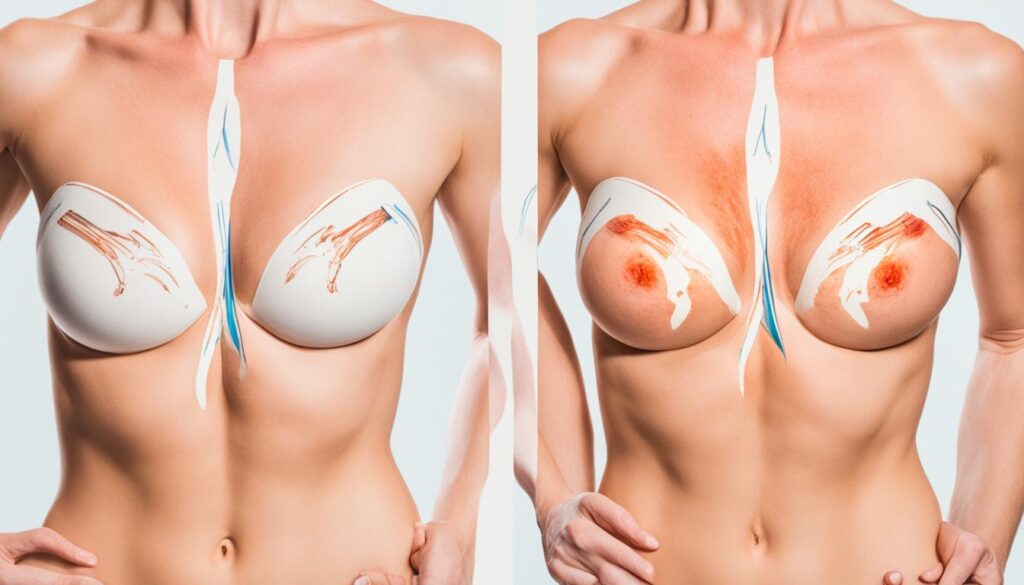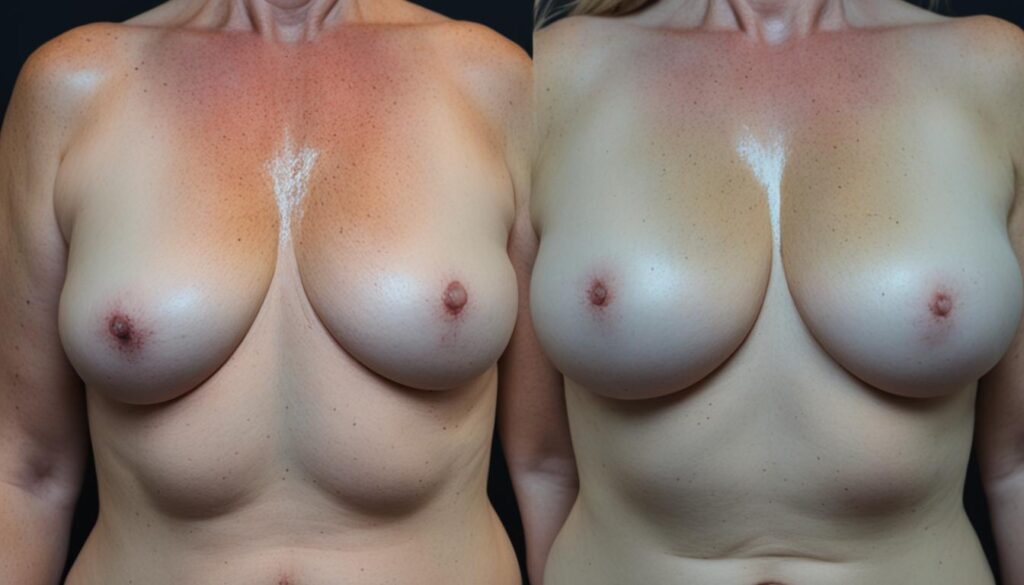Looking in the mirror, I noticed faint lines on my breasts. I wondered if getting breast enlargement surgery caused these marks. I was surprised and worried about dealing with stretch marks.
Stretch marks can happen after breast enhancement surgery. The marks often go away as time passes. Certain things like having a history of stretch marks, using large implants, or undergoing pregnancy can make stretch marks more likely.
But there’s good news. The marks can fade with time. While there are ways to treat them, letting your skin heal naturally is often best. I’m focused on staying positive and thinking about the surgery’s benefits rather than the risk of stretch marks.
Key Takeaways
- Breast enlargement surgery can cause stretch marks in some patients, but they often fade over time.
- Factors like skin elasticity, implant size, and pre-existing conditions can increase the risk of stretch mark formation.
- While treatments are available, allowing the skin to adapt naturally is often the best approach.
- Maintaining a positive mindset and focusing on the overall benefits of the procedure can help manage concerns about stretch marks.
- Working closely with a qualified plastic surgeon is crucial to minimize risks and achieve the desired results.
Understanding Stretch Marks
Stretch marks happen when our skin quickly stretches or shrinks. The tearing of collagen and elastin causes these marks. We see them a lot with elasticity changes like weight changes, pregnancy, and puberty.
What are Stretch Marks?
Stretch marks, or striae, are scars from rapid skin stretching or shrinking. The damage to the collagen and elastin makes the skin look different. It shows up as lines of color on the skin.
Causes of Stretch Marks
Quick skin stretches or shrinks lead to stretch marks. This often happens during pregnancy, changes in weight, or puberty. Challenging the skin’s structure causes these marks to form.
Common Areas for Stretch Marks
We often see stretch marks where skin size changes a lot. Like in the abdomen during pregnancy, or the breasts when growing up. They also appear on the thighs and buttocks when weight changes. Skin elasticity affects how likely we are to get these marks.
Breast Augmentation and Stretch Marks
The link between breast augmentation and stretch marks is intricate. When a breast implant is placed, the skin must stretch. This stretching can lead to stretch marks for some people. It is a common issue.
Factors Contributing to Stretch Marks After Breast Augmentation
Many things can make someone more likely to get stretch marks after breast augmentation. These include already having stretch marks, having tuberous breasts, and using larger breast implants. Those with light and thin skin plus a family history of stretch marks might see this issue after surgery.
Implant Size and Stretch Marks
The breast implant size is key in stretch mark development. Bigger implants stress the skin more, increasing the chance of stretch marks. It is vital for patients and their doctors to choose the right implant size. This is to avoid too much skin stretching.
Skin Elasticity and Stretch Marks
How elastic the skin is also crucial for who gets stretch marks. People with light, thin skin and a family trend for stretch marks are at risk. Their skin might not be very elastic. This means it might not adjust well to changes in breast size.

Can breast enlargement surgery cause stretch marks?
Whether breast enlargement surgery leads to stretch marks depends on how the implants are placed. The technique used is key in the formation of stretch marks.
Implant Placement Techniques
Surgeons might place breast implants in two ways: submuscular or subglandular. It’s important to know these variations to predict stretch mark risks.
Submuscular vs. Subglandular Implant Positioning
Implants under the chest muscle (submuscular) pose a lower stretch mark risk than those above the muscle (subglandular). The muscle protects the skin, reducing stress and stretch mark chances. However, subglandular implants can stretch the skin more, causing more stretch marks when they’re very large.
Learning about implant placement helps patients make smart choices with their surgeons. This understanding can lower the risks of stretch marks after breast augmentation surgery.
Preventing Stretch Marks After Breast Augmentation
Before and after breast augmentation, it’s key to care for your skin. This helps avoid stretch marks. I want my surgery to go smoothly, with good long-term results. So, I’m doing all I can to prep my skin.
Choosing the Right Implant Size
Picking the right implant size is crucial to avoid stretch marks. If they’re too big, they can stretch your skin too much. To find the best fit, my surgeon and I will look at my body shape and goals.
Preparing Your Skin
It’s also vital to prepare my skin well before and after the surgery. This involves using the right skincare with stuff like hyaluronic acid and Centella. These can make my skin more elastic. So, I’m focusing on keeping my skin healthy.

Working with my surgeon and sticking to a good skincare plan, I’m ready to help avoid stretch marks. With the right care, I can ensure my surgery gives me the look I want. This makes me feel positive about my new look.
Treating Existing Stretch Marks
If you have stretch marks after breast augmentation surgery, don’t worry. There are treatments that can make them look better. These treatments help lessen the marks and make your skin healthier.
Topical Treatments
Creams and serums with vitamin E, hyaluronic acid, and Centella can be very helpful. They boost collagen and make your skin more elastic. Topical creams moisturize deeply and support your skin’s repair. This process slowly reduces stretch marks.
Laser Treatments
If your stretch marks won’t go away, laser therapy might be the answer. Dermapen treats them by increasing collagen and elastin production. These make your skin smoother and lower the marks’ visibility. It also helps your skin in general by making it stronger.
Surgical Options
In rare cases, surgical options like a breast lift might be needed for certain kinds of stretch marks. But, this surgery only helps with some stretch marks, not all. Most often, a mix of surgeries and other treatments is suggested for the best result.

Risks and Complications
Breast augmentation is usually safe and works well. But, patients need to know about the possible risks. These include infection, bleeding, uneven breasts, and stretch marks.
Potential Side Effects of Breast Augmentation
Infection and bleeding are serious but common issues after surgery. With proper care, these usually get better. Sometimes, breasts may look different in size or shape. Correcting this may need more surgery.
Stretch marks can also happen. A person’s skin elasticity matters. It might affect whether you get stretch marks after the surgery.
Managing Expectations
Having realistic goals is key. A skilled plastic surgeon can help with this. They make sure bad effects and complications are handled well. They also help you achieve the look you want.
Feeling good about your body is also important. Talk freely with your surgeon and their team about your feelings. This can help make your surgery a success and lead to good results.

Consultation and Planning
Thinking about breast augmentation? It’s key to talk to an expert plastic surgeon first. The breast augmentation consultation starts you on a path focusing on your needs and wishes.
Finding a Qualified Plastic Surgeon
Finding the right plastic surgeon is crucial. Seek out experts with a board certification and lots of experience in this area. Look at their past work, check out what past patients say, and meet them face-to-face to see how they interact.
Discussing Your Goals and Concerns
At the meeting, share your patient goals openly. Also, talk about your worries, like the chance of getting stretch marks or how your breasts might droop. The surgeon will look at your skin, its firmness, and other details important for surgical planning and patient education.
Working closely with your surgeon, you can make a plan that suits you. This plan can help meet your look goals while keeping risks low. It’s a team effort leading to a look that’s both stunning and true to you.
Pre-operative and Post-operative Care
Before my breast augmentation surgery, I made sure I was ready for it. I worked closely with Dr. Emily Henderson. She gave me detailed tips on preparing my body. This was key in avoiding issues like stretch marks.
Preparing for Breast Augmentation Surgery
In the run-up to my surgery, health was my focus. A balanced diet and regular exercise were on my agenda. I also avoided certain medications and supplements as advised by Dr. Henderson. Doing this made me feel ready for a smooth surgery and recovery.
Recovery and Follow-up Care
Recovering after surgery was vital. I followed all of Dr. Henderson’s advice closely. This included wearing compression garments and managing pain. Regular visits with her helped check my healing and skin health. It helped me reach my surgery goals and kept complications low.
